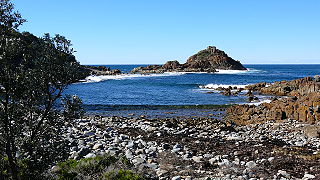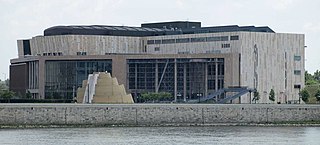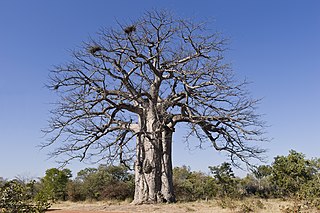
Meroo National Park is a national park in on South Coast of New South Wales, Australia.

Mimosa Rocks is a national park in New South Wales, Australia, 329 km southwest of Sydney near the towns of Tathra and Bermagui. The park is close to Bournda National Park and forms part of the Ulladulla to Merimbula Important Bird Area, identified as such by BirdLife International because of its importance for swift parrots.
The Palms is a small national park located between Cooyar and Yarraman in Queensland, Australia. The main feature of the park is spring-fed gully filled with piccabeen palms. Strangler figs, bunya pines and hoop pines also predominate.

Cunene is a province of Angola. It has an area of 87,342 km2 and a population of 990,087 in 2014.

The Kaokoveld Desert is a coastal desert of northern Namibia and southern Angola.

Müpa Budapest is a building in Ferencváros, Budapest, Hungary, officially opened in March 2005. It is located near Rákóczi Bridge and was designed by Zoboky, Demeter and Partners Architectural Office. The National Theatre, which opened in 2002, is located next to it.
Operation Daisy was a military operation conducted from November 1–20, 1981 by the South African Defence Force and South West African Territorial Force (SWATF) in Angola during the South African Border War and Angolan Civil War. This conflict was sparked when the South African Defence Force decided to try to halt the regroup of the active military branch of SWAPO, also known as the People's Liberation Army of Namibia.
Lumeje is a municipality in Moxico Province, Angola. The seat of the municipality is Lumeje Kameia. It is notable for its national park. Lumeje and Lucano form the boundaries of the park. Cameia National Park was established as a game reserve in 1938 and proclaimed a national park in 1957. The municipality is the location site of two lakes, Lago Cameia and Lago Dilolo, the largest lake in Angola. It had a population of 29,476 in 2014.
Cameia National Park is a national park in the Moxico province of Angola, located at about 1100 m above sea level. Covering a surface of 14.450 km2. It shares its name with the nearby municipality of Cameia. The Cameia–Luacano road forms the northern boundary of the park with the Chifumage River forming the southern portion of the eastern boundary and the Lumege and Luena rivers the south-western boundary.
Cangandala National Park is a national park in Malanje Province, Angola. It is situated between the Cuije river and 2 unnamed territories of the Cuanza, with the towns of Culamagia and Techongolola on the edges of the park. It is the smallest national park in Angola.

Iona National Park is the largest national park in Angola. It is situated in the Southwestern corner of the country, in Namibe Province. It is roughly bound by the Atlantic Ocean to the West, an escarpment to the East that marks the beginning of the interior plateau, the Curoca River to the North, and the Cunene River to the South. It is about 200 kilometres (120 mi) south of the city of Namibe and covers 5,850 square miles (15,200 km2) sq. miles.

The tourism industry in Angola is based on the country's natural environment, including its rivers, waterfalls and coastline. Angola's tourism industry is relatively new, as much of the country was ravaged during the post-colonial civil war which ended in 2002. Unlike most countries in the region, which generally give US, EU, and many other citizens a visa on arrival or require no visa at all, Angola has complicated visa requirements. This procedure towards visitors places the country at a disadvantage in the competitive international tourism market.
Mavinga is a National Park in Kuando Kubango Province in south-eastern Angola. It covers an area of 46,076 square kilometres (17,790 sq mi). The Park was proclaimed in 2011 along with the neighbouring Luengue-Luiana National Park, which measures 22,610 square kilometres (8,730 sq mi). The two parks are contiguous and managed as a single unit. The parks were created to conserve the areas’ high ecological and biological value. Mavinga forms the western border of Africa's largest conservation area, the Kavango-Zambezi Trans-Frontier Conservation Area.

Angolan mopane woodlands are situated in southwestern Angola, extending into northern Namibia. This ecosystem surrounds Etosha Pan, which is considered a separate ecoregion. The mopane trees are the main type of vegetation.
Namibe Partial Reserve is a protected area in Angola. It is located to the north of Iona National Park, and separated by a narrow strip of occupied land along the Curoca River. This reserve has IUCN Category IV status and was proclaimed in 1960 by the authorities of Portuguese Angola. It covers 4,450 square kilometres (1,720 sq mi). This park is planned to be included into the Iona - Skeleton Coast Transfrontier Conservation Area.

Despite being a relatively small country, Albania is exceedingly rich in biodiversity. Its ecosystems and habitats support over 5,550 species of vascular and non-vascular plants and more than 15,600 species of coniferous and non-coniferous evergreens, most of which are threatened at global and European levels. The country has made recent efforts to expand its network of protected areas which now include: 11 national parks, 1 marine park, 718 nature monuments, 23 managed nature reserves, 11 protected landscapes, 4 World Heritage Sites, 4 Ramsar sites and other protected areas of various categories, that when combined, account for 21.36% of the territory. Furthermore, a biosphere reserve, 45 important plant areas and 16 important bird areas are found in the country.
Mupa is a town and commune of Angola, located in the province of Cunene.
The COVID-19 pandemic in Angola was a part of the worldwide pandemic of coronavirus disease 2019 caused by severe acute respiratory syndrome coronavirus 2. The virus was confirmed to have spread to Angola in late March 2020, with the first two cases being confirmed on 21 March.
COVID-19 vaccination in Angola is an ongoing immunisation campaign against severe acute respiratory syndrome coronavirus 2 (SARS-CoV-2), the virus that causes coronavirus disease 2019 (COVID-19), in response to the ongoing pandemic in the country. As of 15 June 2021, Angola has administered 1,314,375 doses of vaccines.822,109 people with the first dose and 492,266 people fully vaccinated. Angola began their vaccination program shortly after receiving their first shipment of Oxford AstraZeneca vaccine in early March 2021.










